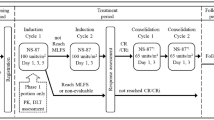Summary
The pharmacokinetics of 8 g/m2 methotrexate (MTX) was compared following short (6 h) and long (24 h) infusions of the drug to 11 children with osteogenic sarcoma (OS; 42 infusion) and 28 children with acute lymphoblastic leukemia (ALL: 118 infusions), respectively. No difference was observed in the first-phase half-life, in systemic clearance or in the volume of distribution of the drug (P>0.05). The concentration of MTX at the end of the infusion was ∼4-fold higher when the drug was given over only 6 h. However, patients receiving 24-h infusions had ∼9-fold higher levels by 24 h after the beginning of the infusion. The area under the data curve from start of the MTX infusion until the beginning of folinic acid rescue administration was significantly higher in patients with osteogenic sarcoma (6-h infusions), while the area under the log-data curve was significantly longer in the ALL group (24-h infusions) for the same period. The latter parameter is considered to be characteristic for the concentration-time-effect relationship. The longer duration of MTX administration (with delayed rescue) is thought to be more beneficial from the pharmacokinetic aspect. Patients with osteogenic sarcoma had significantly lower concentrations of MTX at the end of their last treatment with MTX than at the end of the first infusion. Patients developing MTX toxicity had shorter half-lives of MTX in the beta phase. It is suggested that cisplatin induced tubular loss of MTX and folinic acid is responsible for these observations. A wider application of clinical pharmacologic findings in the practice of the administration of cytostatics is indicated.
Similar content being viewed by others
References
Bender RA (1975) Membrane transport of methotrexate (NSC-740) in human neoplastic cells. Cancer Chemother Rep 6: 73
Bode U (1986) Methotrexate as relapse therapy for rhabdomyosarcoma. Am J Pediatr Hematol Oncol 8: 70
Borsi JD (1984) Simple assay of methotrexate for the practice of clinical oncology. Orv Hetil 125: 2629
Borsi JD, Klepp O, Moe PJ (1986) PharmCalc: Program for the calculation of clinical pharmacokinetic parameters of methotrexate. Cancer Chemother Pharmacol (submitted for publication)
Buchmann S, Fengler R, Hartmann R, Laskari J, Wolfrom C, Ebell W, Gutjahr P, Havers W, Janka G, Neuhaus C, Suder J, Henze G (1987) Comparison of intermediate versus high dose methotrexate for relapsed childhood acute lymphoblastic leukemia. Fourth International Symposium on Therapy of Acute Leukemias, Rome, abstract book, p 405
Chabner BA, Young RC (1973) Threshold methotrexate concentration for in vivo inhibition of DNA synthesis in normal and tumorous target tissues. J Clin Invest 52: 1804
Jaffe N, Keifer R III, Robertson R, Takue Y (1987) Renal toxicity with cumulative doses of cis-diamminedichloroplatinum-II in pediatric patients with osteosarcoma. Cancer 59: 1577
Klepp O (1986) Statmed program in GWBASIC. Nycomed, Oslo
Magrath IT, Spiegel RJ, Edwards BK, et al. (1980) Altered relapse pattern of Burkitt lymphoma in America. Proc Am Soc Clin Oncol 21: 348
Moe PJ, Kolmannskog S, Finne PH, Seip M, Wesenberg F (1987) Methotrexate infusions in childhood acute lymphocytic leukemia. Fourth International Symposium on Therapy of Acute Leukemias Rome, abstract book, p 188
Monjanel S, Rigault JP, Cano JP (1979) High-dose methotrexate: preliminary evaluation of a pharmacokinetic approach. Cancer Chemother Pharmacol 3: 189
Myers CE, Lippman ME, Eliot HM, Chabner BA (1975) Competitive protein binding assay for methotrexate. Proc Natl Acad Sci USA 72: 3683
Ohnuma T, Lo RJ, Scanlon KJ, Kamen BA, Ohnoshi T, Wolman SR, Holland JF (1985) Evolution of methotrexate resistance of human acute lymphoblastic leukemia cells in vitro Cancer Res 45: 1815
Pinedo HM, Chabner BA (1977) Role of drug concentration, duration of exposure, and endogenous metabolites in determining methotrexate cytotoxicity. Cancer Treat Rep 61: 709
Rowland M, Tozer TN (1980) Clinical pharmacokinetics: concepts and applications. Lea and Febiger, Philadelphia
Sirotnak FM, Donsbach RC (1974) The intracellular concentration dependence of antifolate inhibition of DNA synthesis in L1210 leukemia cells. Cancer Res 34: 3332
Author information
Authors and Affiliations
Additional information
The work reported in this paper was supported by a research grant from the Norwegian Cancer Society (Landsforeningen mot Kreft)
Rights and permissions
About this article
Cite this article
Borsi, J.D., Schuler, D. & Moe, P.J. Methotrexate administered by 6-h and 24-h infusion: a pharmacokinetic comparison. Cancer Chemother. Pharmacol. 22, 33–35 (1988). https://doi.org/10.1007/BF00254177
Received:
Accepted:
Issue Date:
DOI: https://doi.org/10.1007/BF00254177




